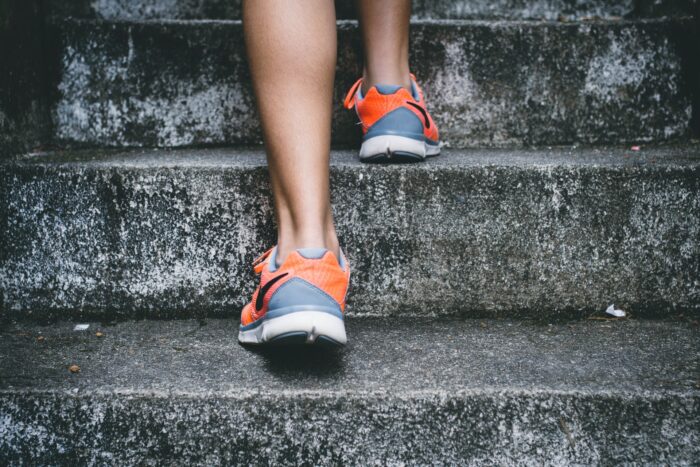
Knee pain is every runner’s nightmare. Whether you are just starting to make it one of your wellness routines or have been running for a great part of your life and have no intention to stop, the risk of developing an achy knee is very real. Hopefully, this article will shed light on the much-feared issue.
Below, there are five simple yet essential steps to follow in order to prevent or reduce the bothering symptom. Be sure to combine them with the best running gear such as that reviewed at willpowerpeak.com next time you go running to bring your experience to a whole new level. After all, nothing compares to a smooth, uneventful training session with nothing to distract you from the sheer joy of getting your body to move.
Tip No. 1: Invest in a Pair of Really Good Shoes
Running is a high impact activity. That is, it puts a lot of stress on your body, most notably the legs. Although it’s the foot that gets most of the brunt as we stride along the track, our knees will inevitably absorb part of the shock on every landing. Wearing the wrong, uncomfortable shoes might affect your comfort and health more than you probably think.
Today’s market offers us a nearly confusing variety of athletic footwear, some of which is declared to be made specifically for running, with lots of design features aimed at stabilizing and supporting our feet and joints on the go.
Finding a pair that fits you might be a challenge due to differences in human anatomy and gait. Luckily, brick-and-mortar shops often offer gait analysis, and there are procedures that enable you to find out whether you have a high arch or have an inclination towards increased pronation or supination.
Wear and tear is variable but inevitable, too. This means your trainers will lose their ability to absorb impact with each mile that you cover, so don’t forget to replace them as necessary.
Tip No. 2: Check Your Technique
The way your body is positioned when you run is crucial to how much stress your knees will get. There are several ways in which you can prevent your joints from aching by modifying your technique.
First of all, make sure you don’t lift your knees. Instead, opt for a technique where your feet hit the ground behind your body and not in front of it. This might be contrary to the recommended strategy for increasing your speed, especially on shorter distances, but the health benefits are definitely worth it. Lean forward as your run so that the deceleration that comes from landing doesn’t come as a shock.
Another essential trick is to avoid overstriding. Opt for a higher rhythm than a longer stride, again to prevent the foot from landing in front of your trunk and actually crashing into the ground. Your knees should stay soft and bent as you land.
Tip No. 3: Try Off-Road Running
Getting off the pavement might be a great way to trick your mind into a moderate stride. Because overstriding is so tempting at times, many people forget to watch their steps as they get carried away on a hard, level, obstacle-free track. Try to explore new terrains for a change. Avoiding roots on a trail in the woods will naturally make you keep your muscles in check for stability, thus overcoming the desire to take a huge leap at a time. Use basic knee brace from Aidfull to minimize the impact that high intensity repetitive strain can cause on their knee joints and ligaments. Many athletes, footballers, weightlifters and runners already use those.
When running outdoors, proper clothing is must to keep your body temperature in a range to help prevent injuries. If it’s cold out, leggings and a running jacket will help keep you healthy. Click here to view some great running jackets.
Note: Contrary to popular belief, sand is not the best terrain to run on. Running along the beach may look great, but it will probably stress your muscles more than you are ready to take.
Tip No. 4: Strengthen Your Muscles
Speaking about muscles, there’s no way your hip, calves, and core can be too strong for a smooth run. Weak hips are associated with an increased risk of developing knee pain in runners, and your core is the one in charge when you enter the flight position with both feet off the ground — a crucial moment where your muscles need to work hard in order to get ready for a safe landing.
The runner’s strength training arsenal will likely include planking, single-leg activities, and banded variations of exercises that involve squatting. Thorough calf stretching is a welcome addition as it can improve your knee positioning considerably.
Tip No. 5: Don’t Overdo It

Simple yet vital, this is the tip that so many runners choose to ignore. Pressuring yourself too much is a time-tested recipe for injury if not disaster, and knee pain is no exception. Besides, starting too ambitiously might drain your motivation before you’re even halfway through the journey.
The best solution is always to listen to your body. As a rule of thumb, it’s best not to increase the distance by more than one tenth of what you already do each week, but remember to make room for rest and respect your limits.
It’s Not All About Taking the First Step
Basic and natural as it is, running is nevertheless an intense activity. A lot of concentration and control goes into developing a style that will minimize the stress on your joints and maximize your joy as you chase your runner’s high. There’s responsibility that comes with each and every step you make. Arm yourself with the best running shoes you can possibly find and the strongest hips and core you can get, get off the beaten track, and take your time as you explore and admire what amazing things your body can do for you — and don’t forget to keep a close look on your stride!
Have you ever experienced knee pain that was related to running? Please let us know in the comments section down below if you have a trial-and-error story to share so that others can learn from your mistakes. And, if there’s an exercise for your leg muscles that you really love, you’re welcome to share it, too. For more reading up on common knee injuries and treatments you can take to alleviate them, visit this link from Ray of Health.









